Dude. I don't believe this guy took the lead from EVH.
Give the edge to your #1 guitar hero.
Last Updated on March 2, 2024 by Teemu Suomala
The bridge is one of the key parts of a guitar (or almost any other stringed instrument), it’s a crucial element. But especially with electric guitars, there are so many different bridge types. TOM’s, Evertunes, Wrap-Arounds, etc.
In this in-depth guide, we look closer at the most common guitar bridge types (both electric and acoustic) and see what each has to offer. We’ll look at the basics of them and weigh to pros and cons. After reading this guide, you literally know more about guitar bridges than 95% of the guitar players. And I can say that when I was done crafting this guide, I really wanted to test a couple of new bridge types out. Ready?
Let’s get started with key parts of the guitar bridge, and then we’ll dive deeper!

Author: Teemu Suomala
Parts of The Guitar Bridge
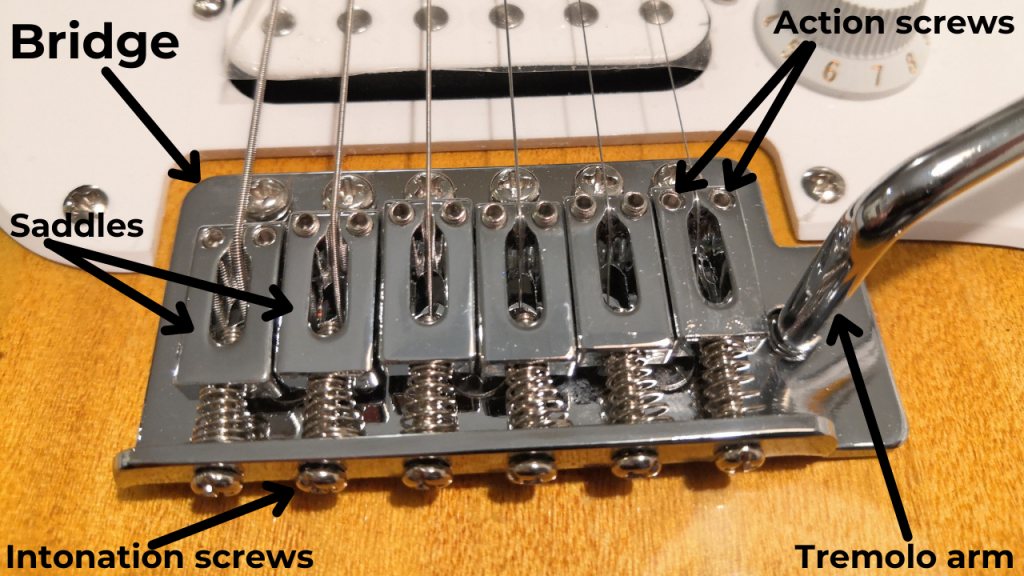
Bridge usually has at least these 2 main parts:
- Bridge unit itself
- Saddle or saddles
With pinless acoustic-, and classical guitar bridges, that’s it. But as you can see from the image above, usually bridges have more parts. These can be:
- Tremolo arm
- Intonation screws
- Action screws
- Bridge cover
- Fine-tuning pegs
- Screws for setting up the wanted tension and pitch
So there are tons of different bridges out there, and these can offer us tons of different features. Some more useful than others. Let’s now look closer at the most common bridge types.
Other guitar guides worth reading:
Electric Guitar Body Shapes and Styles – Explained
Electric Guitar Tonewoods – Tonewood Chart
Guitar Neck Shape Guide – Shapes Explained
Acoustic Guitar Body Types & Styles – Explained
4 Types of Acoustic Guitar Pickups – Which One You Should Choose?
8 Different Electric Guitar Bridge Types – Plus Honorable Mentions
Tune-O-Matic (TOM)

The bridge is screwed to the body from both ends. Usually, strings go through to bridge and go to a separate tailpiece. There are tons of different variations of regular TOM bridges available with different tailpieces.
TOM’s have been used since Gibson president Ted McCary came up with the idea of creating bridge that would make intonation adjustments easy in 1954. TOM ensured that the guitarist could fine-tune the bridge and achieve spot-on intonation.
Nowadays Tune-O-Matic’s are one of the most popular bridges and are still easy to set up and support great tuning stability.
Pros
- String changing is simple
- Small adjustments are easy
- Usually ensure stable tuning (no tremolo)
- Because the bridge is elevated from the body, some people found TOM really comfortable for your picking hand
Cons
- When you have the strings on, adjusting saddles can be tricky without loosening the strings
- Some don’t like the playing feel of an elevated bridge
Usually found from the following guitars
- Les Pauls and Single Cut guitars
- Hollow-Body guitars
- Metal guitars (ESP, Schecter, etc.)
Wrap-Around Bridge
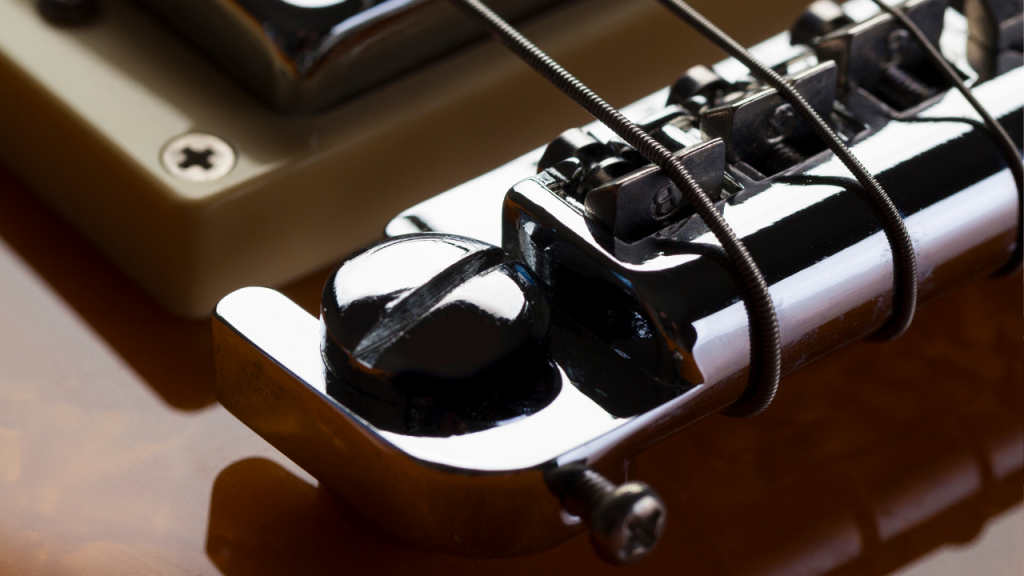
Connected to the body with 2 screws from both ends. Doesn’t have a tailpiece, strings are wrapped around the bridge.
Wrap-under bridge was used on first Les Paul in 1952. Next year, it was replaced with a wrap-over(aka.wrap-around) bridge which is basically just like a regular wrap-around bridge nowadays.
Getting spot-on intonation with a regular wrap-around bridge is not smooth as with 6-saddle bridges. Wrap-around bridges typically have only 2 small screws at both ends of the bridge and with these, you adjust the intonation of all strings.
Some wrap-around bridges have individual saddles for each string and with these setting up a spot-on intonation is much easier. You can see a wrap-around bridge with individual saddles and easier intonation setup in the image above.
Pros
- Doesn’t require a separate tailpiece (saves space)
- Supports tuning stability (no tremolo)
- Tons of different variations available, with some, setting up intonation is easier
- Because the bridge is elevated from the body, wrap around-bridge can be really comfortable for your picking hand
Cons
- You need to loosen the strings every time you adjust the bridge (not handy)
- With regular wrap-around bridges setting intonation perfectly can be tricky since there are only 2 screws for this purpose
- Some don’t like the playing feel of an elevated bridge
Usually found from the following guitars
- Les Pauls and Single Cut guitars
- Hollow body guitars
Fixed/Hardtail Bridge
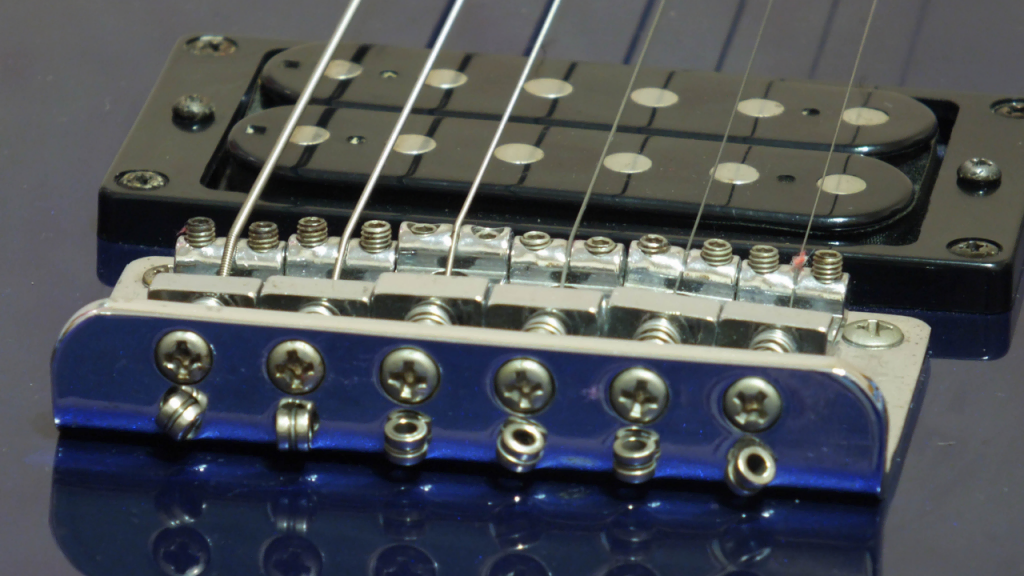
Usually screwed to the body from either 2 or 4 spots. Has 6 separate saddles which each are connected to the bridge with 1 screw. Each saddle has 2 small screws that make adjusting action really easy.
Fender released their Legendary Stratocaster lineup in 1954. Their selection included both, synchronize bridge with the tremolo version and a hardtail version. And this is the first time hardtail bridge as we know it today was introduced.
Hardtail bridge makes adjusting the action of each string according to your preference easy with its 6 saddles. Also, each string has a screw for adjusting the intonation, so from setup perspective, hardtail is an amazing bridge type.
Pros
- Adjusting the action of each string separately is possible
- Adjusting the intonation is easy
- Super simple design
- Slim bridge works for some players
- No tremolo, so tuning should be stable (at least from a bridge perspective)
Cons
- Some players don’t find slim & flat design very comfortable for picking hand
- Nothing fancy
Usually found from the following guitars
- Stratocasters
- Modern Stratocasters (Ibanez and Jackson models for example)
Ashtray Bridge (Telecaster)
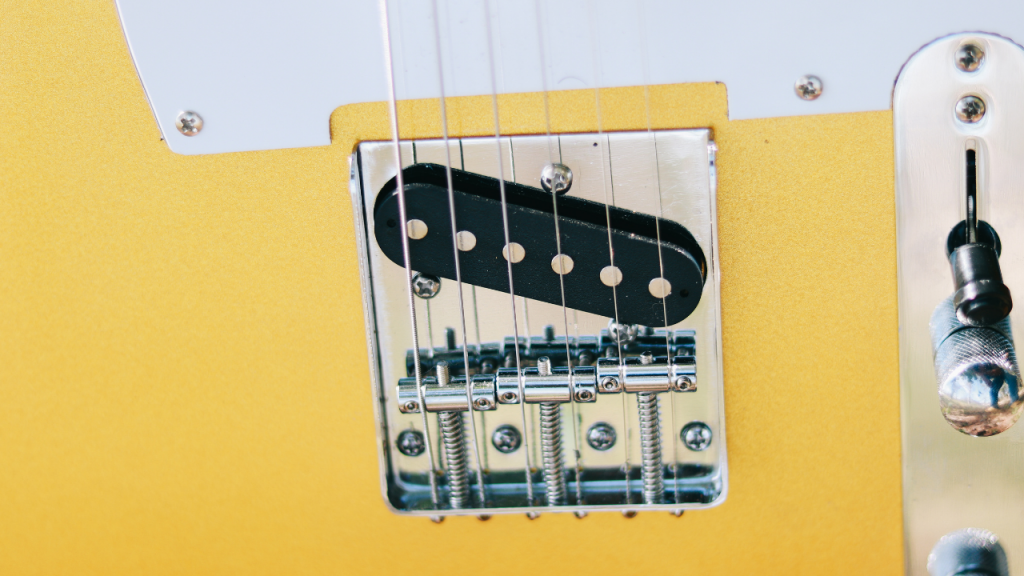
First Telecasters released in 1951 came with ashtray-looking cover over the bridge. The cover can be removed and under it is a tray that, well, can be used and probably was used as an ashtray.
When the ashtray cover is on, palm muting is impossible, so most models don’t come with the cover nowadays.
This bridge is screwed to the body with 4-7 screws. It usually has 3 saddles, 2 strings sharing 1 saddle. Each saddle is connected to the bridge with 1 screw.
The action of each string can be adjusted almost completely separately with 2 small screws located at both ends of the saddle. The reason why I say ”almost” is the fact that adjusting 1 screw can affect both strings sharing one saddle.
Some Telecasters have these same kinds of saddles but don’t have the ashtray design.
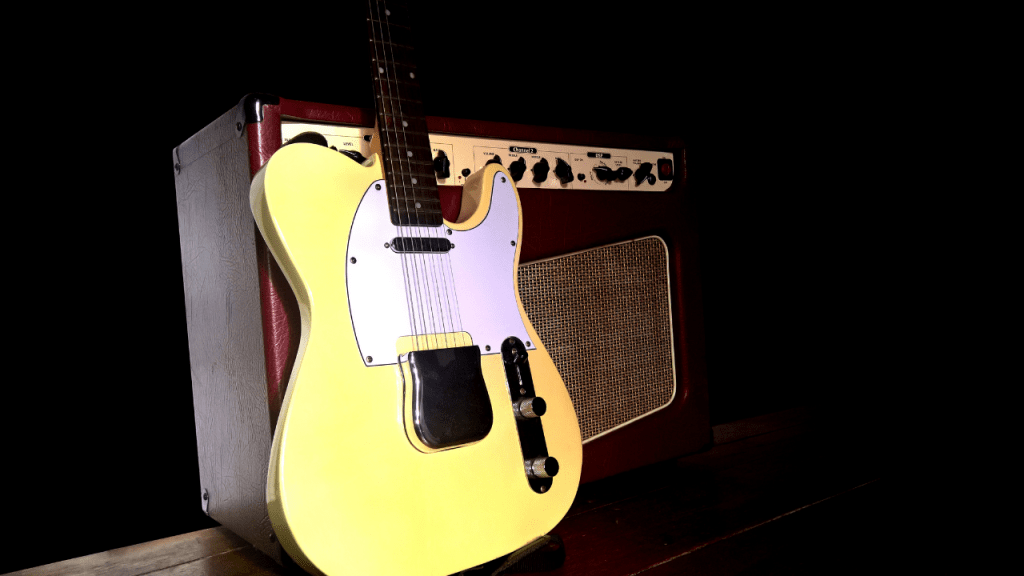
Pros
- If the cover is on, palm muting is impossible (nowadays most ashtray bridges don’t come with a cover)
- You can adjust the action of each string almost completely separately (adjustments might affect other strings sharing the same saddle)
- You can adjust the intonation of 2 strings at the same time
- No tremolo, so tuning should be stable (at least from bridge perspective)
Cons
- You can’t adjust the intonation of each string separately
- Some might find this bridge and its saddles a bit alien when it comes to playing feel
Usually found from the following guitars
- Telecasters
- Some Broadcaster models
Synchronized Tremolo Bridge
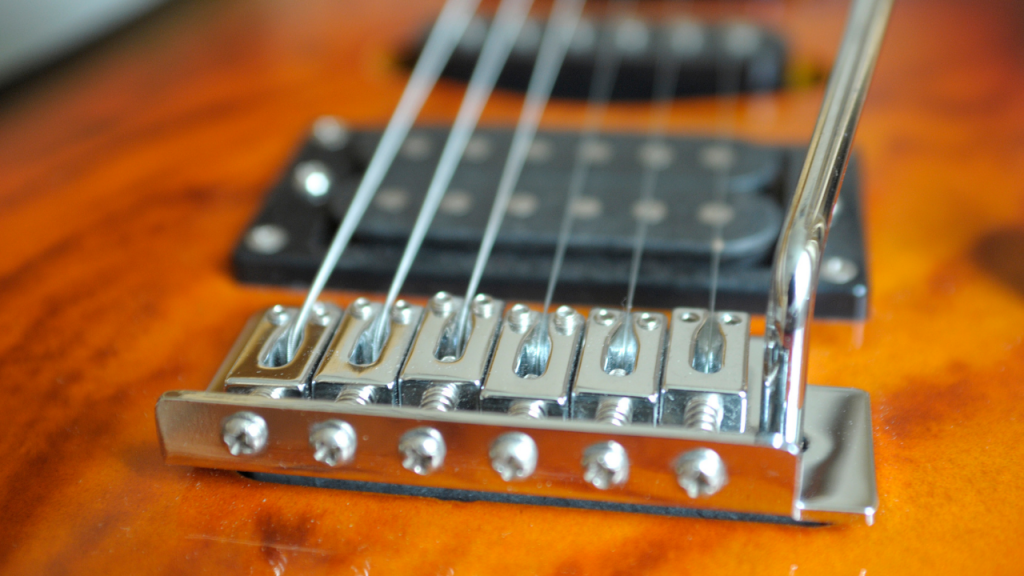
Basics
Synchronized bridges are usually screwed to the body using 2-5 screws. The bridge has a tremolo block attached to it. Tremolo block goes through the body and at the backside, under the backplate, 2-4 springs are attached to it and those strings are connected to the unit that is connected to the body with 2 screws. Confused? Here’s a photo highlighting what’s going on under the backplate:
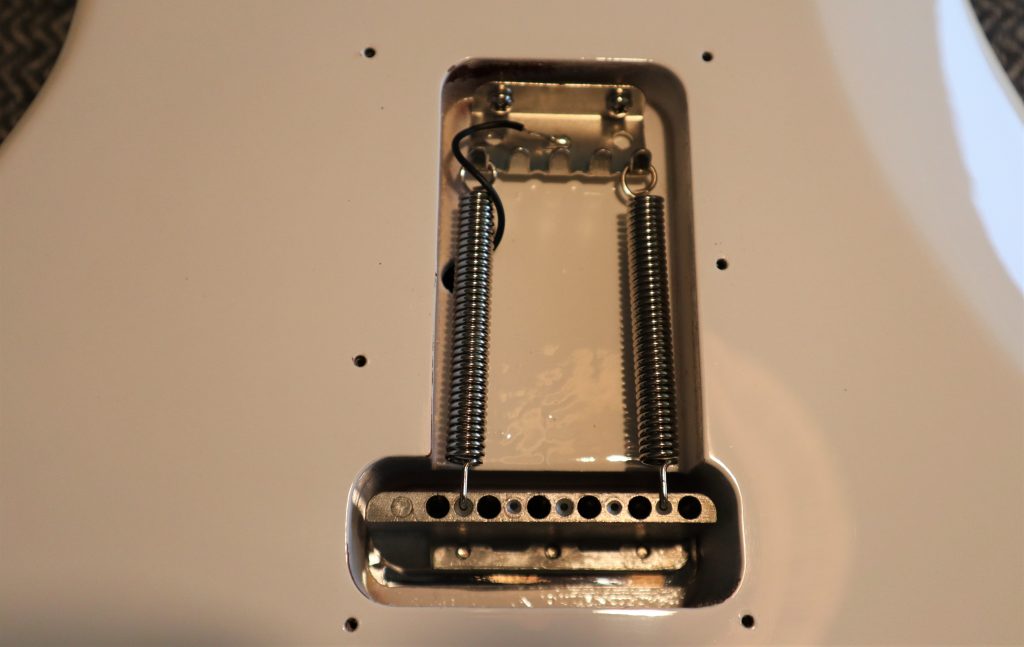
Synchronized bridges have a Tremolo arm(whammy bar) that can make notes played higher or lower. Otherwise, the design is really similar to a hardtail bridge. 6 saddles, each is connected to the bridge with 1 screw and each has 2 little screws for adjusting the action.
Synchronized bridges were first introduced in 1954 when the first Fender Stratocasters were released.
Find cream of the crop guitars with whammy bars here.
Pros
- Similar playing feel to hardtail bridge
- Tremolo arm adds versatility to your playing
- Adjusting the intonation is easy
- Adjusting the action of each string separately is possible
Cons
- Similar playing feel to hardtail bridge
- If you want the tremolo arm to be able to make notes higher, you have to add something between bridge and body when changing strings
- With more moving parts, more things can go wrong
Usually found from the following guitars
- Stratocasters
- Modern Stratocasters (For example several Ibanez & Jackson models)
Floyd Rose Bridge

Also called a floating bridge. Carving on the body wood allows the bridge to move more than with synchronized tremolo. This enables players to better control how low or high they want their notes to play when using the tremolo arm.
Like synchronized tremolo, Floyd rose bridge has springs that can be adjusted from the back of the guitar, under the backplate. With these, players can achieve the right angle for their bridge(usually in line with the body of the guitar) and make it feel more loose or tight.
If you are wondering whether you should get a guitar with Floyd Rose or Tremolo bridge, check this guide: Floyd Rose vs. Tremolo Bridge
Floyd Rose was invented in 1976. Floyd rose combined with locking nut ensures that the guitar will stay in tune even with heavy tremolo arm use. This bridge has been favored by many famous players, such as Eddie Van Halen and Steve Vai.
Pros
- Adds the most versatility to your playing
- You can pull off dive-bombs
- The locking nut ensures great tuning stability even if the tremolo arm is used frequently
- Fine-tuning is possible with the tuning pegs of the bridge
- You can make your playing a lot more interesting by doing cool stuff with a Floyd Rose
Cons
- With more moving parts, more things can go wrong
- Changing the strings takes more effort
- Changing tuning takes more effort
- Setting up everything can be a pain
- Costs more
Usually found from the following guitars
- Ibanez JEM7VP
- EVH Frankie Striped MN
- Find the full list of guitars with Floyd Rose bridges here.
Evertune Bridge
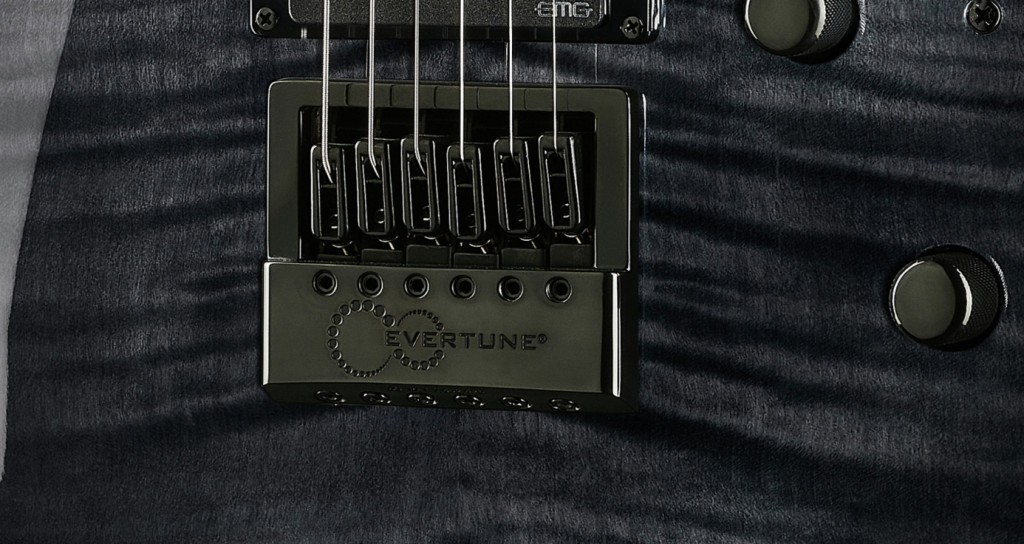
Evertune bridge has separate screws for each individual string. 1 for intonation and 1 for action, but it also has screws for setting up the right pitch for each string inside the saddle. Once this is set, the Evertune keeps constant tension on the string and maintains the pitch the user selected. This allows strings to stay in tune like magic!
Under the hood, there’s a spring and lever that maintain the wanted tensions/pitch of the string. It’s a relatively simple function but works great if maintaining perfect tuning stability is your goal.
Cosmos Lyles (who came up with the idea) and Paul Dowd were the 2 key people who produced the prototype of Evertune. It’s a relatively new invention, but the exact inventing date of it is missing. But in 2010 Evertune raised $800 000 from investors, so that gives us some perspective, Evertune was invented prior to 2010.
Pros
- The guitar stays in-tune like magic, if you use the guitar properly, probably forever
- Surprisingly simple to use
- Really slim build feels comfortable for some players
Cons
- Still harder to set up than hardtail and TOM bridges
- Not always needed if the guitar already stays in tune well
- Costs more
Usually found from the following guitars
- ESP LTD EC-1000 Evertune
- Jackson Pro Series Signature Misha Mansoor Juggernaut
Kahler Bridge
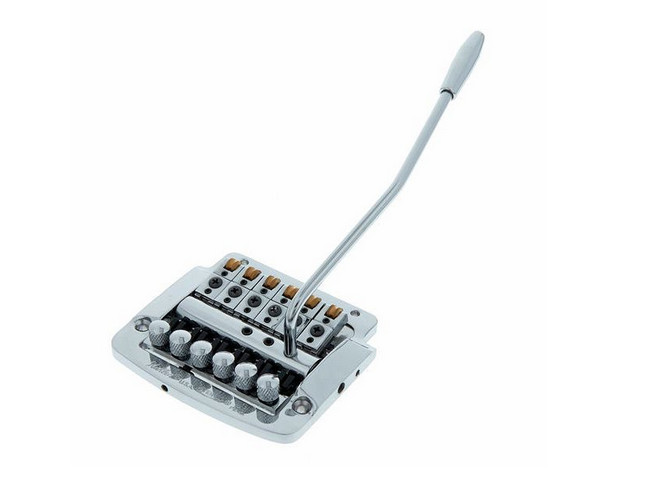
Offers really similar features to Floyd Rose. But there are several differences in design. With Kahler, you don’t have to cut the ball end of the string off and instead of a locking nut, Kahler’s come with a separate locking system that goes to the guitars headstock. Kahler’s also have springs that are on the bridge unit, not at the backside of the guitar like with Floyd Rose.
Using a Kahler is usually a lot smoother since the whole bridge doesn’t move, only the cam does. So you can easily do dive bombs using just 1 finger.
One of the coolest features to me is that Kahler’s bridge can be easily locked and this turns it into a fixed bridge. So basically, you get features of Floyd Rose and Fixed Bridge in 1 Kahler bridge.
Kahler bridges were invented in 1979, but in the 90’s they were not manufactured almost at all. But in 2005 manufacturing continued and Kahler started to gather some traction again. At the NAMM 2011 Kerry King(who has been known for using Kahler bridges), gave signatures in Kahler’s booth.
Pros
- Adds the most versatility to your playing
- Fine tuners have a lot more room for adjustments than with Floyd Rose
- Using tremolo requires a lot less strength/effort than with Floyd Rose or Synchronized Trem bridge.
- You can pull off dive-bombs
- Relatively good tuning stability even when the tremolo is used a lot
- You can adjust the string spacing
- You can lock the bridge and it turns into a fixed bridge
Cons
- Loses to Floyd Rose in tuning stability
- Many people think that the locking system doesn’t look very good
- Heavy use of tremolo causes the cam to give strings extra pressure and they are more likely to snap from near the cam(reinforced ball-end strings can help with this)
Usually found from the following guitars
Based on my research it seems that from currently manufactured mass-market guitars, only Dean has models available with Kahler bridge.
- Dean MD24 Select
- Dean Z Select
- ESP LTD JH-600 (discontinued, but some stores still carry this)
Honorable Mentions
Gibraltar and Edge Bridge, plus Other Ibanez Designed Bridges
Ibanez has designed several different electric guitar bridges over the years. And one of the most well-known are Gibraltar and Edge bridges.
Ibanez Gibraltar bridge
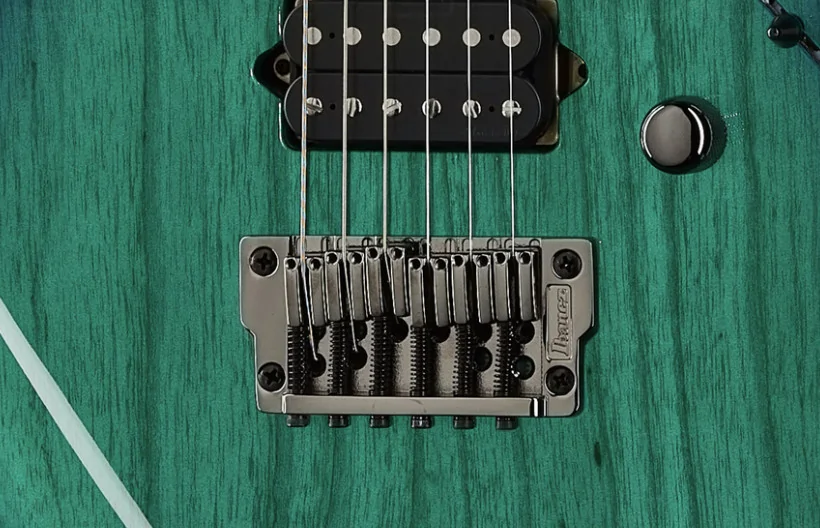
Gibraltar bridges offer us different variations of hardtail bridge and Gibraltar 3 even shares some similarities with TOM bridges. Some key features Gibraltar bridges offer are
- A wide range of intonation changes are possible (great for heavy strings)
- Different looks and playing feel
- Simple and easy setup
Couple guitars with Gibraltar bridge:
- Ibanez AR420-TBG
- Ibanez RG652AHMFX-NGB
- Ibanez AS73FM-TIF
- Ibanez GAX30-TCR
Ibanez Edge bridge

Edge was developed and manufactured by Gotoh, but it’s still a bridge created for Ibanez. The fine-tuning pegs are located further from the strings which ensure that they are not getting in the way of playing. Saddles are also smaller and the edges are less sharp, this can improve the overall playability. The materials, manufacturing style (lost-wax casting), and larger body mass have been claimed to increase the sustain of an instrument.
Couple guitars with Edge bridge:
- Ibanez RG5170B-BK
- Ibanez RG550-PN
- Ibanez RG550-DY
- Ibanez RG370AHMZ
Wilkinson and Gotoh Bridges

Wilkinson models (Gotoh manufactures them) are usually different variations of synchronized tremolo bridge or Telecaster-styled bridge. The biggest difference between Wilkinson Synchronized Tremolo bridge and normal Trem bridges are that with Wilkinson, you can adjust the height of the tremolo arm and set screws on the saddle to lock the bridge to the wanted intonation.
Gotoh’s bridges are different variations of fixed, synchronized, Telecaster, TOM, and other bridges with different designs. These bridges can offer different playing feel, better tuning stability, or other useful features.
Couple Guitars With Wilkinson Bridge
- Reverend Double Agent W
- Harley Benton Fusion-T HH
- Yamaha Pacifica 612V II
- Suhr Pete Thorn Signature OTM
Couple Guitars With Gotoh Bridge
- Ibanez FLATV1-BK Josh Smith
- Charvel Pro-Mod DK24 HH
- Jackson DKR Dinky MJ
- Ibanez YY20-OCS
3 Different Acoustic Guitar Bridge Types
Standard Acoustic Guitar Bridge

A standard acoustic guitar bridge is usually just a piece of wood where saddle and bridge pins are attached to. Tons of different woods, designs, and shapes are used. A couple of the most common woods used on acoustic guitar bridges are:
- Ebony
- Indian Rosewood
The bridge plays a big role in how your acoustic guitar sounds because the vibration of the strings is transferred to the body of the guitar through the bridge (and through the nut and neck of course).
Pros
- Works great
- Simple usability
- Transfers vibration of the strings well
Cons
- It’s annoying to lose a bridge pin
- Really normal
Some acoustic guitar have adjustable saddles, although it is rare, you can find some of the currently available models and more info about them here: Acoustic Guitars With Adjustable Bridge & Saddle (Rare Feature)
Acoustic Guitars With Standard Bridges:
- Yamaha FG-TA TransAcoustic
- Seagull Guitars S6 Cedar Original
- Gretsch G5024E Rancher
Pinless Acoustic Guitar Bridge
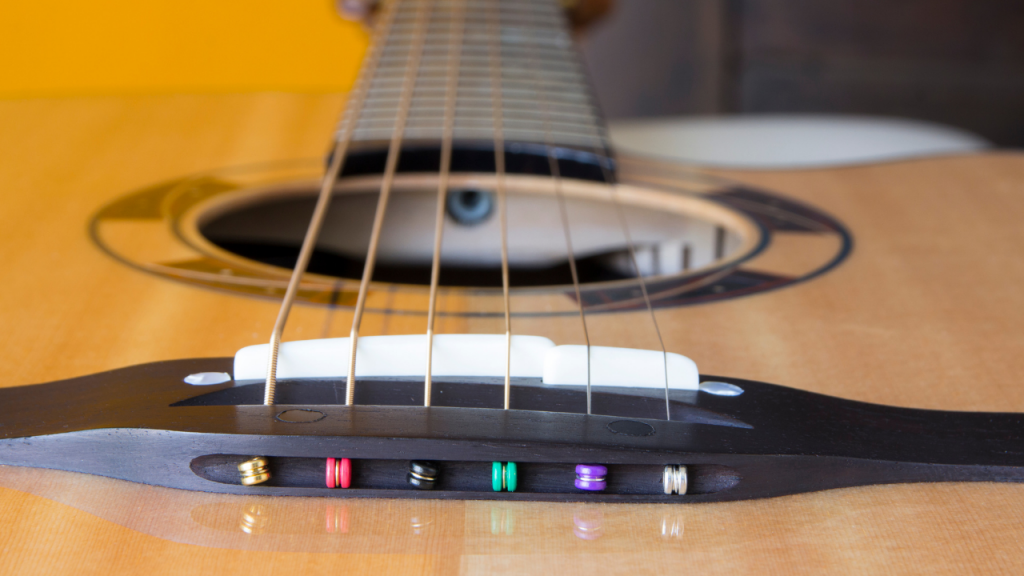
As the name suggests, these kinds of bridges don’t have bridge pins. Breedlove guitars are well known for manufacturing these kinds of bridges. The purpose of Pinless bridges is to eliminate the string/bridge pin holes that are drilled into the body of the guitar, this is claimed to improve the tone of the guitar because it can resonate more naturally since there are fewer holes.
Pinless bridges also make changing strings a bit easier and decrease string break angle which reduces the pressure that strings give to nut, this can potentially increase sustain.
The downside is that pinless bridges can give more pressure to the points where the bridge is connected to the body.
Pros
- No lost bridge pins
- Changing strings is really easy
- Simple design
- This bridge type can offer some tonal benefits
Cons
- Can give extra pressure to the points where the bridge is connected to the body.
Acoustic Guitars With Pinless Bridges:
- Breedlove Jeff Bridges Oregon Concerto
- Breedlove Oregon Concertina CE
- Breedlove ECO Discovery S Concert
Check our comprehensive list of acoustic guitars with pinless bridge.
Classical Guitar Bridge
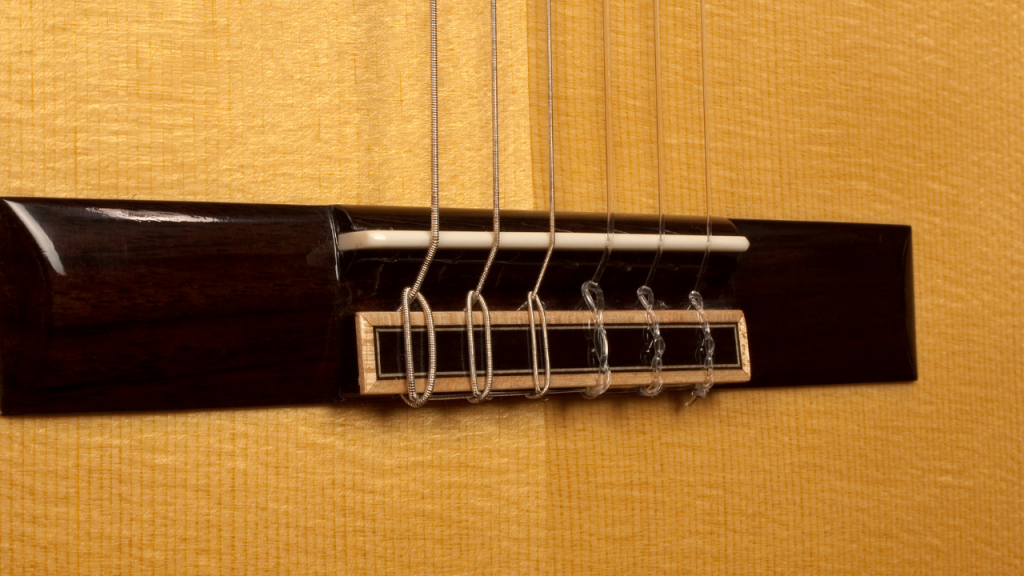
A classical guitar bridge consists of a saddle and a wooden block that has a hole for each string. Strings are run through the hole and held in place by a knot.
Classical guitar bridge is really simple and restringing is easier than most think, even I can do that, so will you.
Pros
- Really simple to use
- This design just works
Cons
- Time to invent something new?
Guitars With Classical Guitar Bridges:
- Ibanez GA35
- Kremona Verea Cutaway
- Yamaha CG122MSH
- Cordoba C9 Crossover
FAQ
What Guitar Bridge Does?
Strings are run through or anchored to the bridge. The bridge then transfers the vibration of the strings to the body of the guitar. Especially with acoustic guitars, the bridge plays a huge role in the tonal characteristics of an instrument.
Bridges can also have different features in them, such as:
- Tremolo arm
- Fine-tuning pegs
- Screws for setting up the intonation
- Screws for setting up the action
The bridge is a crucial part of acoustic and electric guitars, and some features of different bridges can make playing more comfortable, increase sound quality and volume, impact tone, and make life easier in general.
If you are shopping for used guitars, bridge is one crucial part to inspect. Learn more about buying used guitars here.
Does Guitar Bridge Affect Sound?
Yes it does. It impacts how strings vibrate and how the vibration is transferred to the body of the guitar. With bridge adjustments, players can also adjust string action and intonation which play a big role in guitars overall sound.
What is The Difference Between A Saddle and A Bridge on A Guitar?
The bridge is the whole unit where your strings are attached to or run through. Saddles are usually part of the bridge. Strings are directly in contact with saddles.
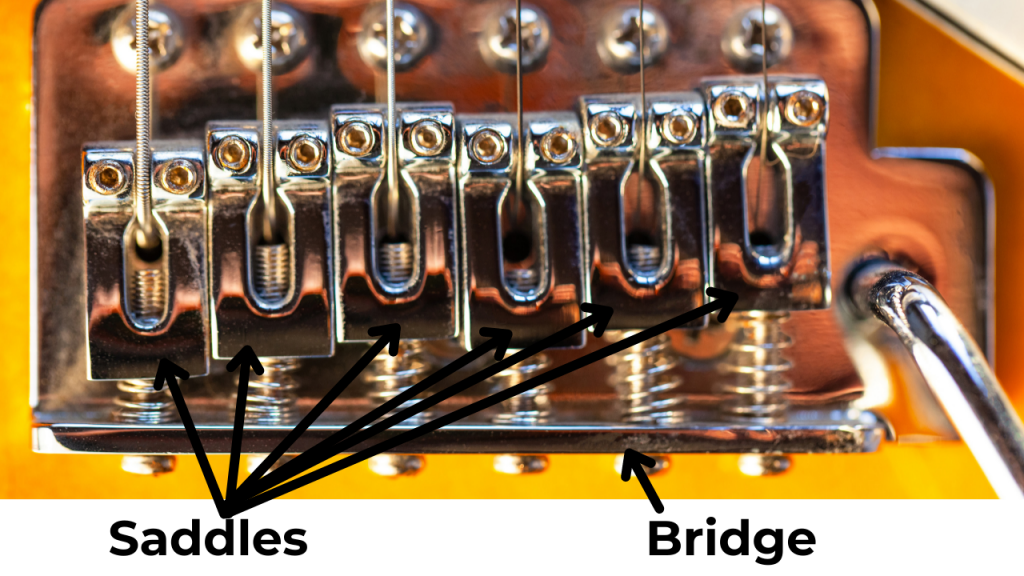
What Guitar Bridge is The Best?
There’s not the one best guitar bridge out there. But different bridges work better for some players. For example,
- If you are after a bridge that allows you to pull off crazy dive-bombs like Dimebag Darrel, Floyd Rose or Kahler bridges are great options.
- If you hate tuning issues, the Evertune bridge is worth looking into.
- If you just want something simple and easy to use, Hardtail and Tune-o-Matic bridges are good options.
So, what guitar bridge is best for you depends on your needs and wants. Get clear on what you need and want, and then dive deep into the world of guitar bridges and choose the best one. By the way, the article you are reading right now is the most comprehensive resource about guitar bridges, so this can help you to make the right choice.
What About Bigsby? Or Stetsbar?
Bigsby and Stetsbard were not included in this article. Why? Because they are not guitar bridges, they are tremolo systems that can be used on guitars.
For example, many guitars with Bigsby tailpiece/tremolo actually have Tune-O-Matic bridge on them, like the one in this picture:
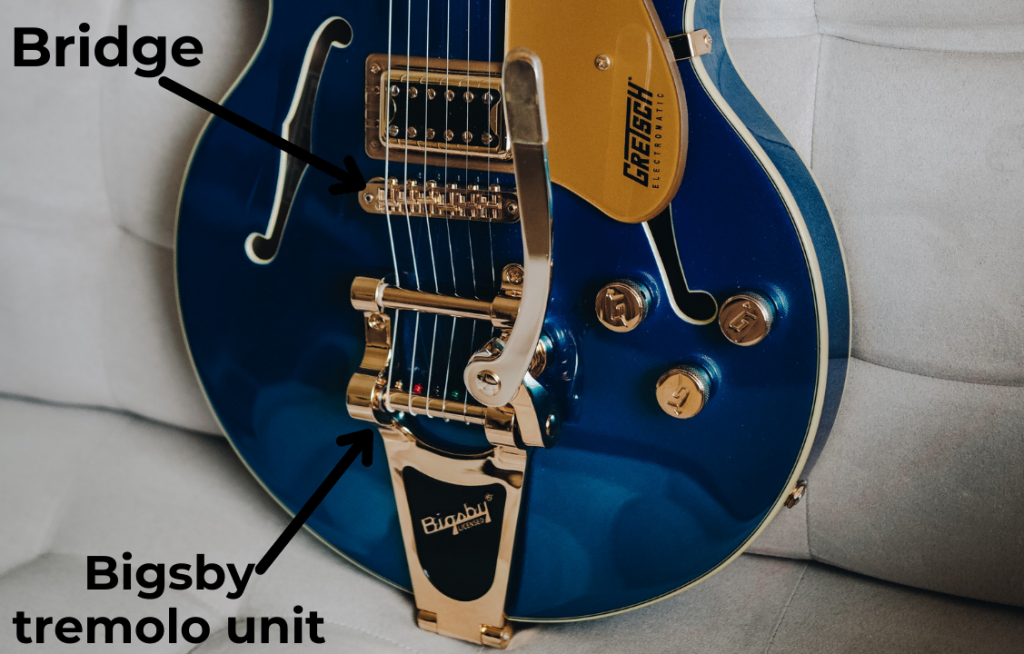
Conclusion
I bet you have learned a ton of cool stuff about guitar bridges. I was really excited to learn more about Kahler and Evertune bridges, and personally, I would like the test a guitar with Kahler bridge as soon as possible. Still, the normal Hardtail or Synchronized bridge are my favorites. Simple things just tend to work for me.
If you have any questions, want to reveal your favorite bridge, or if you think that I missed something, please leave a comment down below.
I wish you all the best and keep rocking!














On pinless bridges: by far these are the most common types of bridges that i deal with in my repair business (www.muskokaguitars.com ) . The attachment systems’ geometry where the string is anchored through holes in the rear of the bridge has a tendency to pull-up at the rear of the bridge and / or / may cause a dip in the soundboard between bridge the soundhole. Claims of improved sound because there is no bridge pin holes are highly questionable.
Steel string guitar bridges woth bridge pins are acoustically superior and less likesly to fail in the long run. They provide better sound transmission when properly set up as there is more string to bridge contact and opportunity to adjust and control the break angle over saddle.
The main element contributing to sound transmission to the soundboard is the composition of the saddle itself . There are variety of materials that will work as a saddle. The main ones are plastic, corian ( harder plastic) wood ( ebony is sometimes used as a saddle) bone , ( mostly cow and pig bone) brass ( super bright sound and will add some sustain) and The Tusq material. Occasionally especially in older cheaper guitars a piece of fret wire will do the trick . High performance instruments classical sand high end steel string guitars tend to rely on bone as a nut and saddle material and should be considered the standard material for their superior transfer of sound energy from the string to the soundboard.
David
Thank you for the great info David! 🙂
Consider omitting a locking tremolo if you intend to use multiple different tunings. Every time you want to adjust the tune, you’ll need to get a wrench and free the strings. You’ll probably find a fixed or Fender-style guitar bridge more practical. Also, note that permanent bridges, particularly those with string-through bodies, tend to have stronger sustain than floating bridges.
Thank you for pointing this important guitar bridge information out!
Great info Teemu. I’m planning to install a TOM on my old Regal resophonic. It will require some machining to get to fit the spider “bridge”. I do have 30 years of machining titanium experience so no problem (ha!). I seem to be sharp on the strings so this could be helpful. Also do have any thoughts on a metal bridge (titanium) being used for better sound transmission? Thanks for any advice.
Hi Chris and thanks for commenting!
That’s an interesting mod. I have not tested different bridge materials so don’t know how it will affect the sound. But I do think that it can potentially affect the sound and especially resonance.
If you wan’t, feel free to update us on your project. Take care!
I just don”t believe you’ve left out the bridge what jazz guitars has – when a metal part at the tail block holds all the strings and the bridge (sometimets movable) only lift the strings to the right height. I’m searching the proper english name of that solution, and none of the articles give a f.. about it .DDD
Hi!
You mean Bigsby Tremolo unit? We talk about it in the end of the article (with photos)…but the thing is, it’s not bridge, it’s a tremolo unit. These things usually have a normal TOM- brigde and bigsby unit comes only after that. Thanks for commenting and take care!